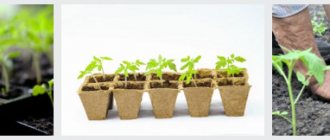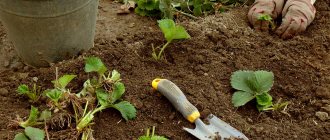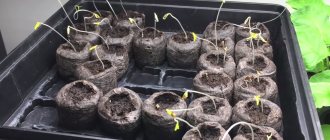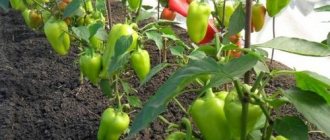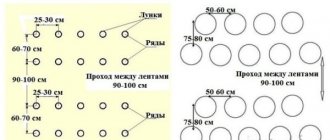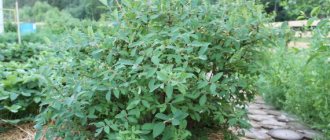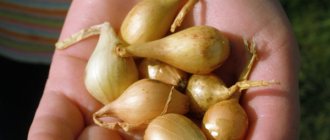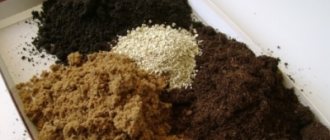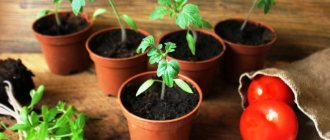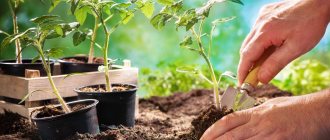Why is it needed?
Thanks to picking, the plant’s lateral roots develop better, which increases the supply of nutrients. The seedlings receive more light, do not interfere with each other’s development, and are better ventilated. As a result, plants are less susceptible to diseases and do not become stretched. Picking is needed in order to help the seedlings adapt to new living conditions after transplanting them into open ground.
After picking, plants receive more nutrients
When to pick tomatoes
Tomato seedlings can be plucked as soon as the first two leaves appear on the seedlings. It’s not possible before, because the root system is still weak. Late picking of seedlings can cause tomatoes to take root poorly and be susceptible to diseases. There are a number of signs indicating that tomatoes need to be picked:
- The tomatoes have reached the required age. Such seedlings have a developed root system to withstand picking.
- Tomatoes are planted too densely. The optimal distance between seedlings is 5 cm. When planted densely, the plants interfere with each other and do not receive the required amount of nutrients and moisture.
- Plants are stretched. If they have too thin stems and a small number of leaves, then picking helps to save the situation. This usually happens when there is a lack of light.
- The seedlings have a depressed appearance. In cramped conditions, it lacks natural light, moisture and nutrients. These plants have too thin stems.
- Signs of illness appear. The most dangerous disease for tomato seedlings is blackleg. Its spread slows down the development of seedlings, resulting in the death of tomatoes.
Caring for seedlings before picking
From the moment of germination to the picking of tomatoes, 10–14 days pass. To obtain healthy and strong seedlings, sufficient illumination and optimal air humidity are important. During this period, seedlings should be kept in a cool and bright place. During the day, in sunny weather, boxes with seedlings can be taken out onto a glassed-in balcony. To prevent plants from stretching out, it is important to provide them with sufficient lighting. For this purpose, additional lighting (LED lamps) is installed. In the first 3 days they illuminate around the clock, then use the backlight only in the morning and evening hours and on cloudy days. To ensure uniform light flow to all plants, the boxes are turned the other way every 2-3 days. If necessary, the air in the room is humidified or ventilated.
How often to water seedlings before picking
After all the seedlings have appeared, watering is stopped for four days, then watered depending on the humidity of the air and soil, after about 3-7 days. At high humidity, the plants become very elongated, the root part of the stem turns black and rots, and the disease “black leg” occurs. The soil should not be allowed to dry out; the soil should be slightly dry before the next watering. You need to water so that the water does not wet the leaves. Water for irrigation is used that has settled for 1–3 days and heated (20–22°). Watering with a weak solution of potassium permanganate once every 7–15 days gives a good effect, while feeding and disinfection are carried out. Compliance with the rules of watering and lighting prevents the seedlings from stretching, which is very important during this period.
Preparatory stage
Before digging up the bushes, you should prepare all the tools and containers so that the tomatoes are in the open air for as little time as possible. A couple of days before the sowing procedure, you should water it generously - moist soil will make the extraction process easier, and it will not be so painful for the seedlings. If it was not possible to irrigate the seedlings in advance, then you need to do this at least a couple of hours in advance.
It is important to make drainage holes in the containers in advance - the soil should not become waterlogged. To do this, you can buy special containers or carefully make holes with a hot nail. Before starting the procedure, you need to fill 1/3 of the container with soil in order to immediately place the seedling in the soil.
Necessary tool
You don’t need any special equipment for picking - just prepare a few long devices that can be used to pry up the seedling. Best to use:
- toothpicks or sandwich skewers;
- knitting needles;
- pencil;
- a pointed stick;
- an ordinary spoon.
You can purchase a special small spatula, but you need to use it carefully so as not to damage the measles system.
Special diving set
Suitable container
Any small container that can comfortably accommodate a separate bush can be suitable for planting seedlings. If picking occurs at the stage of 2 leaves and you plan to repeat the transplant again, then it is better to take containers with a volume of 100-150 ml, and if the next transplant will be carried out directly into the soil, then the containers should be larger - 800 ml or 1 liter. The following containers are best suited for picking:
- plastic cups;
- cans;
- tetra packs cut to half;
- peat pots;
- cut plastic bottles.
The height of the container should be 10-15 cm, and its diameter should be 8-10 cm. Most often, simple plastic cups are used - one seedling fits perfectly in them, holes can be easily made in the bottom for drainage and the container can simply be moved if necessary.
Expert opinion
Stanislav Pavlovich
Gardener with 17 years of experience and our expert
Ask a Question
Important! It should be remembered that the roots of the tomato must fill the entire container, otherwise a fungus may develop in the unoccupied soil due to moisture and kill the plant.
How to cultivate the land
For tomato seedlings, it is best to purchase ready-made soil - it is a high-quality mixture of several types of soil, which allows the tomatoes to receive maximum nutrients during growth. But even to ready-made soil you should add:
- superphosphate;
- potassium sulfate;
- vermicompost.
When preparing the soil, be sure to water it with a solution of potassium permanganate - it will kill all bacterial cells and insect parasites that may live in the soil. For disinfection, the soil is spilled with a solution in a concentration of 0.5 g of manganese per 10 liters of water.
See also Cardinal tomatoes: characteristics of the variety and specifics of cultivation
Determining the deadlines
Since picking takes place at room temperature or in a greenhouse, there is no point in being guided by the weather or temperature outside. The appropriate time for planting is determined by the condition of the seedlings.
Picking should be done only after each seedling has expelled a pair of true leaves - usually this happens 9-10 days after sowing. Each seedling should already be 6-7 cm in height. If for some reason the bushes have not yet formed and are too weak, then it is better to plant them a little later - 14-16 days after sowing.
Expert opinion
Stanislav Pavlovich
Gardener with 17 years of experience and our expert
Ask a Question
Important! Planting should not be carried out later than 20 days after sowing - by this time the seedlings may be tightly intertwined with their roots, and their separation will damage the stems.
How to do a pick correctly
Proper picking of seedlings is the key to a good harvest in the future. You can start diving when 2 main leaves appear on the seedlings. The diving procedure is carried out in the following order:
- 2 hours before the start of picking, water the seedlings in containers; this will make it easy to remove the plants from the ground.
- Remove the seedlings using a wooden stick or spatula, pinch off the central root.
- Fill the seedling pots two-thirds full with soil, make a small depression, place the sprout in it down to the very bottom leaves, carefully straighten the roots and sprinkle with soil.
- Pack the soil tightly around the stem and roots.
- We place the seedlings in a shaded place and water them 1-2 times a week.
After the seedlings take root, they are placed in a sunny place. In order for the seedlings to harden, the room is periodically ventilated. The optimal ambient temperature is 15–18 degrees.
Video: tomato seedlings from germination to picking
What kind of land is needed for picking tomatoes?
Grown seedlings need more nutrition, so the soil mixture must be saturated with useful components, balanced and fertile. The volume and quality of the future harvest depends on the composition of the soil for picking.
Composition of soil for picking tomatoes:
- peat;
- sand;
- garden soil;
- mullein;
- sawdust;
- wood ash;
- chalk;
- mineral fertilizers.
Recipe for picking soil for tomato seedlings:
Mix equal parts of turf, rotted sawdust, humus and peat. Add 1 cup of ash, 1 tsp. urea, 3 tbsp. l. superphosphate and 1 tbsp. l. potassium sulfate.
How to cultivate the land
The ground prepared for picking must be treated with disinfecting compounds. This will prevent the occurrence of seedling diseases, remove fungal spores, pest larvae and pathogenic bacteria, which in the future can prevent tomato seedlings from developing properly.
Potassium permanganate and hydrogen peroxide are effective for disinfecting soil. It is important to prepare the solution correctly to avoid disastrous results.
Potassium permanganate solution for treatment : 1 gram per 1 liter of water. If the solution is saturated, add more water.
Treatment with hydrogen peroxide : 4 tsp. for 1 liter of water.
Where do tomatoes have two true leaves?
When a seed germinates, the first two cotyledon leaves appear. Then real leaves appear, for example, in tomatoes they are carved.
The true leaves of a tomato appear after the cotyledons.
The principle of pinching the root when picking
When picking tomatoes, pinch off the central root by about one-third in order to stimulate the growth of additional lateral roots. This procedure slightly slows down the growth of the plant; the seedlings stretch less and do not outgrow.
Pinching stimulates the formation of lateral roots
How to pick tomatoes planted in tablets
Growing tomato seedlings at home can also be done by planting seeds in peat tablets. They are convenient because they save space when grown in an apartment. There is no need to select soil for seedlings, since the tablets already contain microelements and growth stimulants.
After 3-4 true leaves appear, I transplant the seedlings into 0.5 ml cups with fertile soil.
Holes are made at the bottom of the glass to drain excess water. Then 2–3 cm of soil is poured onto the bottom, the peat tablet with the sprout is placed in a glass and covered with soil almost to the cotyledon leaves. Water the soil with water with the addition of potassium permanganate and place it in a cool, shaded place.
Video: picking tomatoes planted in tablets
Picking tomato seedlings into two roots
There is a way to grow tomatoes on two roots, which allows you to increase the nutrition of the bush and get a larger harvest. For this picking, take two plants and transplant them into a container at a distance of 5–6 cm from each other. When the plants take root and get stronger, they begin to graft. Using a blade, remove the skin from both seedlings in an area of approximately 2–3 cm. Then connect the exposed sections of the stems and wrap them tightly with film tape.
Shortly before planting the seedlings in the ground, select a plant that has developed less well and pinch it at a height of 3–5 cm above the grafting site. Such a plant will develop quickly, as it has a powerful root system.
One bush on two roots gives a larger harvest
How to pick tomatoes without soil
You can grow tomato seedlings without soil, this allows you to save space and keep your apartment clean. To do this you need to prepare:
- strips of plastic film (or plastic bags);
- toilet paper;
- bottom of a 5 liter plastic bottle.
Lay out the plastic film, lay a layer of toilet paper on top and moisten it with water. After this, place the seeds at a distance of 3 cm from each other. Place another layer of toilet paper on top and also moisten it with water. Cover with film tape and roll into a roll, not too tightly. To prevent the resulting “snail” from falling apart, you can fasten it with an elastic band. We put the finished rolls in a tray from a 5-liter bottle, pour water into it. Now it is important to ensure that the paper does not dry out. After germination, the containers are placed in a well-lit place.
Picking such seedlings is not difficult at all: unroll the roll, carefully separate the plant and replant it in cups with soil.
This method saves time and allows you to keep your apartment clean.
Picking tomatoes without true leaves
Picking tomato seedlings can also be done at the cotyledon stage. Especially if the seedlings are stretched, they must be picked without delay. The roots are not pinched, the plants are carefully separated and planted in separate containers. The seedlings are taking root well. After transplantation, leaves begin to appear after about 5–6 days.
How to properly plant tomatoes for seedlings in a diaper: step-by-step instructions
Picking tomatoes planted using this method is very easy, so you can handle the job without any problems. In addition, seedlings after such picking will never get sick. The procedure is performed as follows:
- Prepare all the necessary tools, including film (you can replace it with other similar material).
- Cut out rectangles from the film. They should look like a piece of notebook paper.
- Place soil (1 tbsp) in the left corner at the top of the diaper.
- Place the plant on top of the soil. The leaves should be above the diaper.
- Add soil again (1 tbsp). Take the soil slightly moist.
- To prevent the film from unfolding, secure it using an elastic band.
Caring for tomatoes after the procedure
In order for plants to quickly take root and develop well after picking, they need proper care. It is important to comply with the necessary conditions: lighting, temperature, hardening, watering, fertilizing. Plants are gradually accustomed to sunlight, trying to prevent sunburn. During the day, the seedlings are taken out onto a glassed-in balcony, the recommended air temperature is + 16–18 C. At night, they are kept on the windowsill with the window open (air temperature + 14–15 C). Hardening increases the resistance of seedlings to temperature changes.
How often to water
Watering is carried out once a week with settled warm water. It is necessary to ensure that the soil does not dry out; it is recommended to periodically lightly loosen the soil.
What to feed
The first feeding is carried out 2 weeks after the dive, subsequent ones with an interval of 2 weeks. To do this, use ready-made fertilizers, diluting them in a consistency of 1 cap per 1 liter of water, as well as mineral fertilizers containing nitrogen and phosphorus. There are ready-made fertilizers for tomatoes in stores.
Why don't seedlings grow after picking?
Incorrectly carried out picking is one of the most common reasons leading to the stopping of seedling growth. There are several reasons for the death and poor growth of tomato seedlings:
- Errors during transplantation. The root is incorrectly located in the hole or damaged; the ground is not covered tightly enough. The presence of air bubbles prevents the development of the root system.
- Lighting. Direct sunlight often causes burns on seedlings, which negatively affects their health and growth.
- Diseases, for example, blackleg. Develops due to watering tomatoes with cold water.
- Pests, such as spider mites.
- Irrigation errors and drainage problems. Stagnation of water causes rotting of the roots of seedlings, and watering with cold liquid causes the development of a disease, the so-called black leg.
- Poor quality soil with low mineral content. For example, a lack of iron causes yellowing and dying of leaves, as well as a significant slowdown in seedling growth. Low nitrogen content is indicated by excessively thin stems and limp leaves.
- High indoor temperature. If excessive moisture is added to it, putrefactive processes occur in the soil. As a result, the root system and the entire plant suffer.
Why do seedlings die?
The causes of death of tomato seedlings after picking are often various diseases. The most common of them are the following:
- Rot. The cause of the disease may be overwatering or too low air or soil temperatures. In this case, diseased plants cannot be saved. Seedlings that remain healthy must be urgently transplanted into a new container.
- Blackleg. With this disease, the plant stem becomes thinner at ground level and becomes like a thin brown thread. The result is the death of the seedlings. The disease can develop as a result of waterlogging of the soil, lack of lighting, heat, or too dense planting. You can save seedlings only at the very beginning of the disease. To do this, water the soil with potassium permanganate and loosen it. In case of dense planting, seedlings are planted more rarely.
This is what blackleg disease looks like
Transshipment
The method of growing tomatoes without picking can also be considered correct. However, initially the seeds should be placed in small containers and then replanted. In this case, transshipment is performed. The procedure involves transferring the plant to another container along with a lump of earth in which the roots are located. That is, it is enough to carefully remove the earthen lump from the container and place it in a larger pot, filling the voids with soil mixture.
In this way, tomatoes that were sown in peat tablets are also transplanted. In the future, the tablets are simply transferred to large pots and sprinkled with soil.
After the first transplant (by picking or transferring), it is planned that the seedling will be in a larger container immediately before it is planted in the garden. However, in some situations the procedure may need to be repeated. Such manipulation may be necessary if the tomatoes are pulled out or the soil is depleted.
Related article:
Tomato Andromeda F1 - characteristics and description of the variety
The second transplant is carried out approximately 3 weeks after the picking. At the same time, the soil is not watered 1-2 days before it is carried out. The soil should be dried a little so that it can be easily removed from the pot, since the second transplant is carried out using the transshipment method. That is, the earthen lump is not destroyed.
Why do seedlings fall after picking?
Tomato seedlings are very sensitive to growing conditions; they require a certain temperature, lighting, and watering. Therefore, if the seedlings begin to fall, you must first eliminate the unfavorable factors.
- First of all, you should not plant plants too close to each other. When diving to transplant to a new place, choose the strongest seedlings. Weak and lagging sprouts should be discarded immediately; they still will not produce a good harvest.
- If you prepare the soil for picking yourself and take a plot of it, it is necessary to treat it against possible disease damage. This is done by freezing the earth and frying it in the oven. After this, water the soil with a weak solution of potassium permanganate.
- In addition to the soil, it is useful to treat the seeds themselves, also using a solution of potassium permanganate. The seeds are placed in the mixture for half an hour, then dried a little and sown in the prepared soil.
- To grow healthy seedlings, it is important to provide young plants with sufficient sunlight. If there is a lack of natural light, install additional lighting.
- Another necessary condition for growing healthy seedlings is proper watering. It is better to do it early in the morning, water it infrequently, but abundantly.
If seedlings grow in comfortable conditions, but still fall, the reason may be various tomato diseases.
Fusarios is a fungal disease. This disease often occurs if the seeds were not treated (for example, with potassium permanganate) before planting. The fungus begins to develop on the roots, gradually rising to the top of the plants. The seedlings fall and look as if they have not been watered for a long time. In this case, the plants need to be transplanted into uninfected soil (buy special soil for tomatoes).
Blackleg is a disease that affects tomatoes if they are not properly cared for. It occurs when watering too frequently and moisture stagnation. This disease is easy to notice when examining the plant: the tomato stem turns black, then the roots die, and the leaves wither. In this case, you need to spill the ground with a weak solution of potassium permanganate, loosen the soil well and add wood ash to it.
Emerging difficulties
If the picking was carried out correctly and the roots of the plant and the stems were not damaged, then most likely the seedlings will take root well and will delight the gardener. Otherwise, you will have to carefully monitor the seedlings and help them grow.
Seedlings don't grow
If the seedlings stop growing after planting, this is normal. For some time, the seedlings must spend energy restoring the root, and the bush stops growing. This usually takes 5-8 days. If the sprouts were picked ahead of time, adaptation will take up to 2 weeks.
In this case, you should carefully monitor the soil temperature and add superphosphate to the soil - it will have a stimulating effect on the seedling and it will begin to grow.
The plant dies
If the seedlings begin to wither, you should check the soil for moisture - this often causes root rot. It is necessary to stop watering, check the drainage holes and, if necessary, widen them. Also make sure that all care conditions are met - the room is warm, the soil is not waterlogged, and the tomatoes receive sufficient lighting.
When picking, it is very important to disinfect the soil with a manganese solution and sprinkle it with wood ash - this will protect the seedlings from blackleg. If one bush has wilted, it should be removed from the rest of the seedlings and checked for bacterial or fungal infection.
